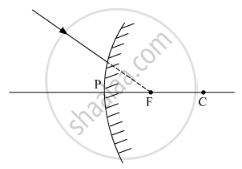Advertisements
Advertisements
प्रश्न
The magnification produced by a spherical mirror and a spherical lens is + 0.8.
(a) The mirror and lens are both convex
(b) The mirror and lens are both concave
(c) The mirror is concave but the lens is convex
(d) The mirror is convex but the lens is concave
उत्तर
The mirror is convex but the lens is concave
Because both convex mirror and concave lens have positive magnification.
APPEARS IN
संबंधित प्रश्न
What is meant by (i) principal focus of a convex mirror, and (ii) focal length of a convex mirror?
In a convex spherical mirror, reflection of light takes place at:
(a) a flat surface
(b) a bent-in surface
(c) a bulging-our surface
(d) an uneven surface
An object is placed at a long distance in front of a convex mirror of radius of curvature 30 cm. State the position of its image.
Give two uses of a convex mirror. Explain why you would choose convex mirror for these uses.
An object is placed at the following distance from a convex lens of focal length 15 cm:
(a) 35 cm
(b) 30 cm
(c) 20 cm
(d) 10 cm
Which position of the object will produce:
(i) a magnified real image?
(ii) a magnified virtual image?
(iii) a diminished real image?
(iv) an image of same size as the object?
A driver uses a convex mirror as a rearview mirror. Explain the reason with the help of a ray diagram.

To determine the focal length of a convex lens by obtaining a sharp image of a distant object we generally follow the following steps which are not in proper sequence.
(a) Hold the lens between the object and the screen
(B) Measure the distance between the lens and the screen
(C) Select a well lit distant object
(D) Place a screen opposite to the object on the lab table
(e) Adjust the position of the lens to form a sharp image
The correct sequence of these steps is:
(A) c, a, d, e, b
(B) c, d, a, e, b
(C) c, d, e, a, b
(D) c, a, e, d, b
The image formed by these mirrors is ______ than the object.
If the object is at infinity in front of a convex mirror the image is formed at infinity.
